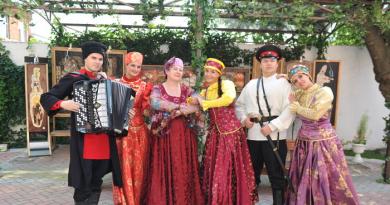First stage. We do not use number notation
The primary task is to teach counting to 10 , n e using the corresponding numbers. Actions with objects come to the fore. For example, there was one spoon, they put another one - there were two spoons. Then you can increase the number of spoons by saying the name of the number.
Will help you solve this problem practical tasks. For example, ask your child more often about the quantity of something: how many plates, how many slippers, how many birds are on that branch. You can count anything, even the steps of a staircase.
Second stage. Getting to know the numbers themselves.
In the first grade, the numbers 1, 2, 0 are first studied, and then 3, 4, 5, 6, 7, 8, 9. The position of zero is determined by the fact that at first it is difficult for the student to understand why emptiness is indicated by a number. And then, when operations with numbers are already practiced, it becomes clear why zero is needed. For example, there were five apples on the table, five were eaten. There is nothing left, that is, zero.
Another option: These drawings are shown, and the teacher asks the children: “What has changed?” They will note: “Nothing.”
The second example shows that if three dots are completely removed from one square, then there will be an empty square and no dots left at all.
The main rule that children must understand when counting to ten is that each number is less than the next number by one and more than the previous number by one.
Techniques for learning to count to ten:
- Train game. A common practice for learning numbers in first grade. One student comes out in front of the class, he says that he is the first car. After that, another one comes out and says: one and one more will be two. And this continues until ten. Then the operation is done in reverse order. The cars “fall apart” one by one. The purpose of this exercise is to remember the order of numbers forward and backward.
- Display on the line. This is an outdated method based on rote memorization and visual proof of the order of numbers.
- Counting on fingers. Traditional and easiest for children. Can be used at first until the child understands the order of the numbers. Then you need to wean them off your fingers by telling them the “secrets” of converting numbers.
- Using funny poems and cartoons about numbers. It will be interesting to watch the cartoon “How the Little Goat Learned to Count” or recite rhymes.
Memory poems for learning counting
Berry count
A fox walked along the edge of the forest:
- One, there’s a strawberry in the basket,
Two are like blueberries in the sky,
Three - ruddy lingonberries,
And four is a cloudberry,
Five - a little currant,
Six is like a viburnum bead,
Seven is like a rowan tree like the sun,
Eight - blackberries in the paw,
Nine is blue blueberry,
Ten - juicy raspberries.
Here's a full basket!
One - hand, two - hand -
We're making a snowman!
Three is four, three is four,
Let's draw the mouth wider!
Five - let's find a carrot for the nose,
Let's find coals for the eyes.
Six - let's put our hat on askew.
Let him laugh with us.
Seven and eight, seven and eight
We'll ask him to dance.
Nine - ten - snowman
Over the head - somersault!
What a circus!
Let's go for a walk, fingers
And the second to catch up,
Third fingers run,
And the fourth on foot,
The fifth finger jumped
And at the end of the road he fell.
- Game "Name the neighbors of the number". For example, you need to name the neighbors of the number 4.
- Exercise “The numbers got lost”. You need to put the randomly arranged pictures with numbers in order. There is another interpretation of this exercise: Baba Yaga mixed up all the numbers. Help me arrange them correctly.
- There were 10 chicken legs visible under the fence. Question: How many chickens are there in total? - Counting in twos: 2, 4, 6, 8, 10 - five chickens.
- How many boots should three goslings be given? Similar to the previous problem.
- The most convenient way to count in fives is by watching the clock.
How to learn the table of addition and subtraction within ten?
After the child knows the order of numbers, it is useful to use tasks on the composition of numbers. You can, of course, memorize the composition of the number 5, for example, but it is better to use game actions with objects with a parallel focus on memorization.
For example:
There were 4 oranges in one plate and 2 in the other. How many oranges are there in total? (Task to find the sum)
There are only 6 apples, and three friends. Divide each equally, equally.
You can also combine small diagrams with simple tasks that are easy to use in the classroom and at home.
It is not difficult to give the following example of the commutative law of addition: one plate with two apples lies on the table, and another plate with four apples lies side by side; if you swap them, the total number of apples will still remain the same.
How to teach a child to add and subtract by passing through tens?
In the example below, to add the numbers 8 and 5, the second addend is expanded to complete the first addend to ten, and then the remainder is added to ten.
As for subtraction, the minuend is decomposed according to its digit composition. Using the example of 15 minus 8, we see that the number 15 is decomposed to its digit units. The result always turns out to be 10 and digit ones - 5. Now: the subtrahend must be decomposed into terms. The first term will be the digit units from 15, and the second term will be selected (children know the composition of the number 8). Now all that remains is to subtract the second term from the eight from 10. And the answer is ready. With a little practice, you can easily solve such examples in your head.
For a child primary school Only three tables are important:
- addition and subtraction up to ten;
- with a transition through ten;
- multiplication table.
Knowing these three tables, it is easy to study further mathematics in the middle grades. Therefore, a child’s first count is his first steps into the world of mathematics. And it is desirable that these steps be in game form, because an interesting and visual form of exercises helps you learn to count faster and with greater motivation to gnaw on the granite of the science of mathematics.
The child is two years old. It's time to start learning to count. First, teach him to count from one to five. While walking, count trees, children on the playground, entrances to the house, cars. Absolutely everything can be counted. When reading a book, do not skip the illustrations. Let the child count the number of drawn balls, puppies, kittens, and so on. If you are interested how to teach a child to count, then know that poems and counting rhymes are good for teaching counting.
The kid must realize that he learns to count for a reason - he benefits from it. He now knows how to divide the candies equally. Before going to the store, tell your child: “We need to buy so many things. Remember: onions, beets, carrots, potatoes, bread - only five purchases. Remind me, please, otherwise I might forget something.” When listing purchases, bend your fingers, then ask your child to repeat the list. When shopping in a store, if your child forgets to tell you what to buy, ask him yourself: “Do you by any chance remember what we need to buy?” After your purchases are made, be sure to count them. If suddenly something is missing, check everything with your child again. The child, realizing that his mother cannot cope without him, will try to concentrate, and thereby train his counting skills and auditory memory. And then you will no longer worry about how to teach a child to count. If your child remembers the entire shopping list, be sure to praise him. Next time the task needs to be made more difficult.
Playing shop will help strengthen counting skills. It will be easier to play with kids without money. Three-year-olds, by the way, are more interested in the payment process. At the same time, you can play without using real money, but using “family currency”: candies, candy wrappers or buttons. You can reward your child for making correct calculations. For example, invite him to divide five sweets among three people, and let him keep the extra ones.
If your child has learned to count, you can move on to learning numbers. The main thing is that the baby understands that the numbers indicate the number of certain items. (Two apples or two candies are always indicated by one number - the number 2.) Kids really like magnetic numbers and various “Velcro books” that are attached to the refrigerator, tiles or to a special board. If the child always has numbers before his eyes, he will learn them even without his noticing.
When the baby learns the numbers from one to ten, then introduce the concept of “zero”. To do this, you can invite your child to count what is not there. “If we have candies, then we can count them, and if we have eaten all the candies and there is nothing left, then we have “zero candies.” The word “zero” means that “there is nothing.”
These days, children can use a computer and a calculator, but they find it difficult to do mental math. The brain, just like muscles, needs regular training. And mental arithmetic, studied from early childhood, is good for development. mental abilities.
Ready for math classes It just doesn’t suddenly appear, it is formed. Already from the age of three, along with numbers, you can teach your child the first lessons in mathematics. You will be convinced that the results will exceed all your expectations.
You should explain to your child what it is “more - less”, “equally”.
Has everything started to work out? It's time to start mastering basic mathematical operations: minus, plus, equal. “You have two apples, they gave you another, you got three apples.”
It is better to learn to count to 10 on your fingers - it is also useful gymnastics. To add two and four, you need to raise two fingers on one hand and four on the other and count how many fingers are “open” in total. You can count using candies, toys and counting sticks. It is useless to insist that the child simply remember that five plus three equals eight. The child needs to understand the mechanism of counting: first, it is necessary to count how much there was, then how much was added, and then how much became. Explain subtraction in the same way: we count how much there was, then how much needs to be subtracted, then how much is left. Here you need to remember the following: when adding, you always get more than it was, and when subtracting, on the contrary, it becomes less.
Explain to your child that no matter what order he puts the objects in, the result will be the same. For example, if you first put three apples on the table, then two more pears, then there will be five fruits on the table. And if you first put two pears, and then two apples, you will still get five fruits. This will explain the primary law of addition: “The sum does not change by changing the places of the terms.”
Today there is a large selection of manuals and books on sale on how to teach a child to count. However, before purchasing them for your child, study them yourself very carefully. You should avoid examples that contain phrases such as “try to guess how much you get” or “determine without counting.” Because this is a flawed approach to math classes. Mathematics is an exact science; it does not guess, but counts. You cannot teach children to count using questions such as “guess”, “guess”, since they have ambiguous answers and the child may think that the correct answer can simply be guessed and not calculated.
Mathematical calculations contribute to the development of mental abilities, memory, ingenuity, and help to form logical thinking. The sooner you start training your child's brain using math calculations, the faster your efforts will bring good result.
You can make games that will help you strengthen your mathematical calculation skills with your own hands.
"Feed the fish"(5-7 years)
This game will help strengthen counting skills and number composition within ten. Teaches how to solve mathematical problems and use mathematical symbols.
Rules of the game: The child must solve the example and put the fish at the correct feeder.
Manufacturing:
Cut out circles and write numbers on them. Then draw fish (you can take ready-made ones from the Internet) and cut them out. We use them to write examples of addition and subtraction.
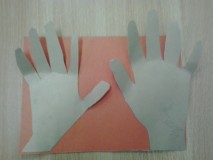 "Palms" This game will help you easily perform computational actions. Rules of the game: The child uses his palms to count. Bending the required number of “fingers” Manufacturing: Trace children's hands onto cardboard, cut them out and glue them onto a sheet of paper, leaving the fingers unglued.
"Palms" This game will help you easily perform computational actions. Rules of the game: The child uses his palms to count. Bending the required number of “fingers” Manufacturing: Trace children's hands onto cardboard, cut them out and glue them onto a sheet of paper, leaving the fingers unglued.
The material was prepared by teachers: Tyurina T.N., Mastrikova N.V.
It would seem that there is nothing complicated in counting, but kids completely refuse to understand why after ten there is eleven, and after twenty there is twenty-one. They switch numbers or skip them altogether, driving their parents to despair. “It seems like he’s not a stupid boy, but he can’t understand such little things! What will happen next?
The thing is that a baby’s memory is very selective. Children learn only those things that interest them, delight them, surprise them, or somehow frighten them. It is unlikely that they will quickly remember something that they consider uninteresting, even if adults insist on it. Therefore, parents need to interest the baby so that he himself wants to count. In this case, little fidgets won’t even notice how easy it is to count.
Linguists have long noticed that when learning languages, people most easily master numerals. If learning writing and the alphabet requires special conditions, then learning to count does not require sitting at a table with a pencil and a book. You can count everywhere: at home, in transport, while walking.
How to teach counting to 10?
The child is already two years old, which means it’s time to start learning to count. First, teach him to count to five. While walking, study the number of trees, children on the playground, entrances to the house, cars. Absolutely everything can be counted. When dressing your baby, draw his attention to the fact that there are only one tights, but always two socks, one hat, two boots, and so on. When returning from a walk, be sure to look through all the shoes in the hallway. Let your son or daughter think for themselves about how many people can wear four shoes. When reading a book, do not skip the illustrations. Let the child tell you the number of drawn balls, puppies, kittens, and so on. Also remember that good poems for teaching counting are small poems with rhymes.
Among other things, the baby must realize that he learns to count for a reason - he benefits from it. Thus, he now knows how to divide the candies equally. When setting the table, ask your child for help, let him give you a certain number of spoons, because this number of people will be dining, and not vice versa, for example: “There will be four for lunch, because there are four spoons on the table.”
Before you go to the store, tell your child: We need to buy so many things... Remember: onions, beets, carrots, potatoes, bread - only five purchases. Remind me, please, otherwise I might forget something.” When listing purchases, bend your fingers, and then ask your child to repeat the list. When shopping in a store, if your child forgets to tell you what to buy, ask him yourself: “Do you by any chance remember what we need to buy?” After your purchases are made, be sure to count them.
If suddenly something is missing, check everything with your child again. The baby, realizing that his mother cannot cope without him, will try to concentrate, and thereby train his counting skills and auditory memory. If your child remembers the entire shopping list, be sure to praise him. Next time the task needs to be made more difficult.
Playing shop will help strengthen counting skills. It will be easier to play with kids without money. Three-year-olds, by the way, are more interested in the payment process. At the same time, you can play without using real money, but using “family currency”: candy, candy wrappers or buttons. You can reward the “clever guy” for correct calculations. For example, invite him to divide five sweets among three people, and let him keep the extra ones.
Digital alphabet
If your child has learned to count, you can proceed directly to learning numbers. Usually, kids simply memorize numbers from one to ten. The main thing is that the baby understands that the numbers indicate the number of certain items. Whether it is three kittens, three apples or three balls, it is always indicated by one number. Kids really like magnetic numbers and various “Velcro books” that are attached to the refrigerator, tiles or to a special board. If the child always has numbers in front of his eyes, he will learn them even without his noticing.
When the baby learns the numbers from one to ten, then introduce the concept of “zero”. To do this, you can invite your child to count what is not there. “If we have candies, then we can count them, and if we have eaten all the candies and there is nothing left, then we have “zero candies.” The word “zero” means that “there is nothing.”
Older children (four to five years old) can be taught how numbers are formed. Place ten counting sticks in a row - in ancient times ten was called "twenty" for short. Place one stick on top (preferably it should be a different color). Thus, “one” by “twenty” becomes “eleven”. Add one stick at a time to the top row and gradually reach twenty. Then explain the formation of tens: two tens is “twenty”, and three tens is “thirty”, etc.
The exception is the number forty, which in ancient times meant “very many” and ninety, meaning “nine to a hundred.”
How to teach counting from one to one hundred?
When teaching your child to count objects from one to one hundred, you don’t need to require instant memorization. It is best to move step by step, for example, increasing your knowledge by ten every week. The next day, before starting to study new numbers, you should repeat what was covered yesterday. You can move on only if he has mastered the previous material well. In this way, he will gradually learn to count from one to one hundred. It is necessary to remember that the baby must understand the count, and not memorize it. Mathematics is based on finding patterns and understanding. The child needs to figure out exactly what principle the numbers are arranged in this way and not otherwise.
Reinforcing the material you have learned, offer your preschooler the following task:
What number is before the numbers 5;9;21;46;85;100.
Name the number after the numbers: 8;16;26;57;82;99.
Name the number between numbers 5 and 7; 11 and 13; 45 and 47.
Find the missing number: 5,6,7,9,10.
If counting to one hundred is not difficult for your child, then you can start learning how to count backwards. It is best demonstrated on the fingers, bending them, or on counting sticks. It's worth starting with five. Here, a lot depends on the characteristics of the baby, namely on what kind of thinking he has better developed: imagination or spatial thinking. It happens that a baby easily makes quite complex mathematical calculations, but counting backwards turns out to be difficult for him. Don't push! Show him the countdown clear examples, for example, when descending in an elevator.
Applied Mathematics
These days, first graders can use a computer and a calculator, but they have a hard time doing mental math. The brain, just like muscles, needs regular training. And mental arithmetic, studied from early childhood, is good for the development of mental abilities.
Some parents are sure that their children, especially those under 5 years old, are not yet ready to study verbal counting. But readiness for mathematical studies does not just suddenly appear, it is formed. If such readiness is not developed, then it may not even manifest itself by the age of ten. Already from the age of three, along with numbers, you can teach your child the first lessons in mathematics. You will be convinced that the results will exceed all your expectations.
You should explain to your daughter or son what “more or less” means. While reading a book, draw your child's attention to the drawing. Invite him to count the images on it: flowers, butterflies, and so on. For example, is there enough flower for each butterfly? Who are more present here: flowers or butterflies? When playing dice, be sure to count them. Let the child demonstrate which cubes are more numerous: small or large, yellow or red, wooden or plastic. At first, it may be difficult for a child to distinguish between concepts such as “a small cube and a large one” and “which cubes are more numerous,” but there is nothing to worry about.
Main training
To explain to your child the concept of “equally,” use examples such as: “Lena has two dolls and Masha also has two. Who has more dolls? No one has! Because there are equal numbers of them.” Invite your child to divide four apples equally among two people, six among three, and so on. Then move on to simple logic problems. For example, there are four squirrels sitting on a branch, each with one nut. How many nuts are there in total?
Has everything started to work out? It's time to start mastering basic mathematical operations: minus, plus, equal. “You have two apples, they gave you another one. Thus, we got three apples.” It is better to learn to count to 10 on your fingers - it is also useful gymnastics. To add two and four, you need to raise two fingers on one hand and four on the other and count how many fingers are “open” in total. The same can be done with candy, toys and counting sticks. It is useless to insist that the child simply remember that five plus three equals eight. The child needs to understand the mechanism of counting: first, he needs to find out how much there was, then how much was added, and then how much became. Explain subtraction in the same way: we calculate how much there was, then how much needs to be subtracted, then how much is left. Here you need to remember the following: when adding, you always get more than it was, and when subtracting, on the contrary, it becomes less.
Explain to your child that no matter what order he puts the objects in, the result will be the same. For example, if you first put three apples on the table, then two more pears, then there will be five fruits on the table. And if you first put two pears, and then two apples, you will still get five fruits. With this you will explain to your child the primary law of addition: “The sum does not change by changing the places of the terms.”
Today there is a large selection of manuals and books on early child development. However, before purchasing them for your baby, study them yourself very carefully. You should avoid examples that contain phrases such as “try to guess how much you get” or “determine without counting.” Because this is a flawed approach to math classes. Mathematics, as we know, is an exact science; it does not guess, but calculates. You cannot teach children to count using questions such as “guess”, “guess”, since they have ambiguous answers and the child may think that the correct answer can simply be guessed and not calculated.
Often, parents of first-graders complain that their children have humanitarian warehouse intelligence and they have no ability in mathematics. However, to do mathematics you do not need to have special abilities. Mathematical calculations themselves help to increase mental abilities, develop memory, ingenuity, and help develop logical thinking. The sooner you start training your baby’s brain using mathematical calculations, the faster your efforts will bring good results.
Some parents don’t want to bother and simply hire a tutor, while others entrust this to grandparents. But caring parents take all the responsibility for learning to count numbers themselves.
And when it comes to learning, parents realize that this is not an easy task and a lot of effort must be made for a positive result. Misunderstandings arise between the “teacher” and the child, tears, nervous breakdowns and hysterics appear.
And in this case, parents simply do not understand why their smart baby cannot learn such an easy task as counting numbers.
How to teach a child to count numbers
It will be easier to teach your child to count numbers if you approach this activity and learning absolutely calmly and without a belt, of course. If your child is about to go to school, but he still hasn’t learned to count numbers or confuses them, and you don’t have enough patience and time, then of course, in this case you need to entrust the matter to a specialist. In the meantime, let’s figure out how to teach counting numbers at home.
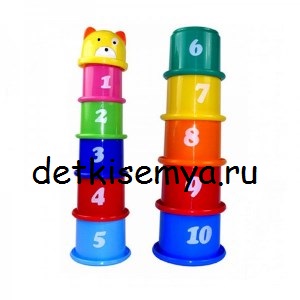
Teaching a child to count to 10
One of the first tasks is to teach your child to count to 10. If your future schoolboy already knows all the numbers, then it’s time to start learning how to count up to 10. What will you need for this? Yes, absolutely everything. Everything that surrounds you, for example, houses on the street, animals, plants, kitchen mugs - everything that is near you. Just don’t force your child to count to 10 every 25 minutes.
After 3 years, it is quite possible to quickly teach a child to count to 10. You should definitely repeat the numbers in any conditions to consolidate the result.
Now there is a lot of useful and educational material, so it won’t hurt you to use it either.
Counting sticks
The simplest teaching material for counting numbers is sticks. Everyone probably remembered their childhood and colorful counting sticks. Some had plastic ones, and some had wooden ones. We have both at home, but my daughter gives greater preference to this set. She inherited it from her older brother.
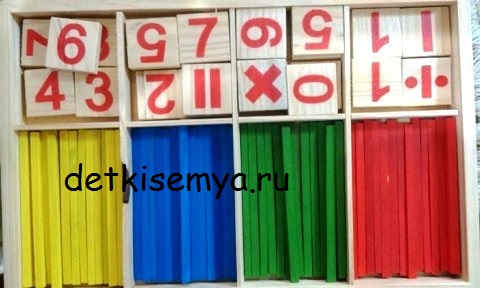
Using counting sticks, your child can come up with different tasks. For example, write numbers on cards and turn them over reverse side, draw the cards in turn, each person will take into his hand exactly as many sticks from the common pile as were written on the card. As a result, you can count and award the winner.
Counting sticks are the simplest material for learning to count. And don’t forget, first you need to teach your child to count numbers up to ten. And when your child has mastered the material well, the count can be increased to 20. Counting sticks will also help you with this.
How to quickly teach a child to count to 20
If your baby already knows how to count to 10, then the next step should be the number 20. After fixing the number sequence from zero to 10, you need to explain to the child that after ten the same counting rules apply. Show him how numbers up to 20 are formed - ten and one, ten and two.
Children can easily remember numbers up to 20 and count them. Help them remember numbers by adding 2 numbers at a time, for example 11 to 12, then starting over until 14 and so on.
Did you know that teaching children to count and explaining to them the meaning of numbers is not the same thing. If you teach children to count, at the same time you should explain to them the concept of numbers and what they are needed for.
Give your child time to remember that “tsat” is added to the end of a word. Quickly teaching a child to count to 20 does not mean rushing him. If your fingers were enough to count to 10, then to count to 20, you can ask your baby to take off his socks and please his toes, also with mathematical skills.
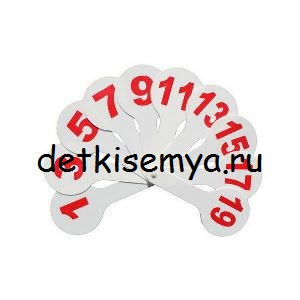
Don’t rush to learn counting to 20 in a day, don’t rush things. Use the same sticks for counting, play while learning, encourage.
How to teach a child to count by tens
To teach your child to count by tens, the easiest way is to use flashcards. They can be cut out of colored cardboard, with three cards for the number 10, three cards for the number 20, and so on. It is necessary for the future student to know that after the first ten comes the second, then the third, and so on up to 100.
Older children can be explained how tens are formed: two and twenty, three and twenty, and so on up to 90. A child can learn to count to 100 when he understands the principles of numerical composition and connection.
How to teach a child to count backwards
Start learning to count backwards with the number five. You shouldn’t immediately fill your child’s head with big numbers. Start with the steps; you can also use cards or the same counting sticks.
But the first thing you should do is write these numbers, both in ordinal value and in reverse. The child must see this clearly. To teach a child to count backwards, you also need to resort to tricks. Buy raisins for a young mathematician, for example, they are good for the body and good for mastering mathematical calculations. I ate one raisin and counted it back. And so many examples can be given.
As you can see, to teach a child to count numbers, there is nothing complicated; you can use counting sticks, and then completely switch to teaching numbers in reverse order.
You have made enough efforts for your child to learn to speak. Now you are faced with the next task - learning to count. When should this be done? Does the baby need special conditions? How to teach a child to count by numbers? Which methods are most effective? We will try to help and make this process interesting for you and your child.
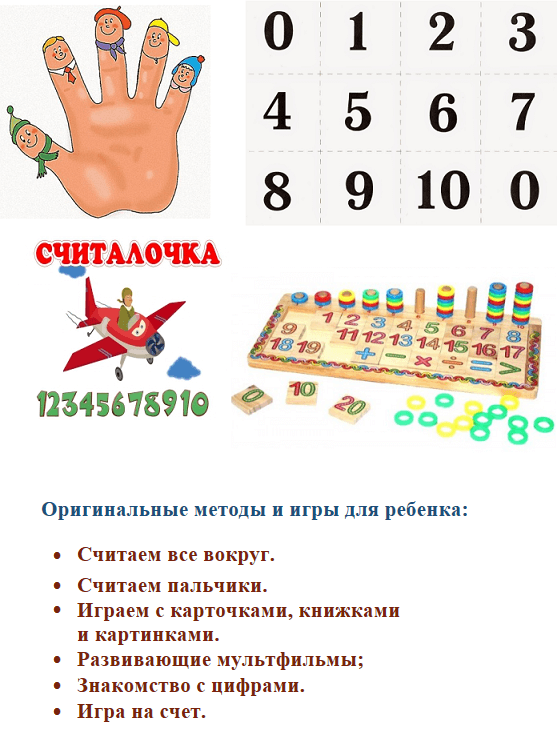 Before you start teaching numbers with your child, it is worth deciding when it will be appropriate. Studies conducted by scientists and teachers have shown that it is quite easy to explain number sequences and other new information to a child aged 2 to 3 years.
Before you start teaching numbers with your child, it is worth deciding when it will be appropriate. Studies conducted by scientists and teachers have shown that it is quite easy to explain number sequences and other new information to a child aged 2 to 3 years.
The fact is that children are now literally “absorbing” everything new, and it is during this period that parents must make sure that the information they will invest is most useful for the development of new skills and abilities in the child. During this period, the baby himself reaches out to everything unknown, take advantage of this to teach him to count.
- At the age of one year, a child begins to realize that “1” and “2” are different concepts, although he is still too young to finally comprehend quantitative states. He is already interested in signs and numbers by their appearance, so from 1 to 3 years old you can teach your child mental counting in a playful way.
- If you maintain curiosity and engage in development, children as young as 5 years old not only count by numbers, but also perform logic problems. And when they go to first grade, they count numbers up to one hundred or more, and do tasks related to them. True, you can teach your child to write numbers earlier.
- Remember that each baby is unique, each has its own character and characteristics of mental processes. And if a neighbor’s boy at 1.5 years old can remember numbers, but your baby, who is barely 3 years old, is not yet familiar with them, it’s not scary.
By not comparing your son or daughter with others, but by encouraging and engaging, you will help him or her quickly learn a series of numbers and even add them, as well as apply them in life.
Under what conditions do we teach?
There are no restrictions here. You don't need a specially equipped class for this. You can work with your baby both through special lessons and during everyday activities. The creative approach of mom, dad and other loved ones will help with this.
So, for example:
- Children are taught to count objects around them while walking and, especially, while shopping, adding up the number of products purchased;
- While in line, you can count next standing people- how much is in front of you and how much is after.
- Focus your baby's attention, for example, on the number of buttons on another mother's clothes and on the clothes of her son or daughter. Let your little one compare;
- You can recite various rhymes, starting from infancy, the main thing is patience and perseverance. In a couple of years you will see the result. This way, you use both auditory and visual memory.
How to teach your child numbers
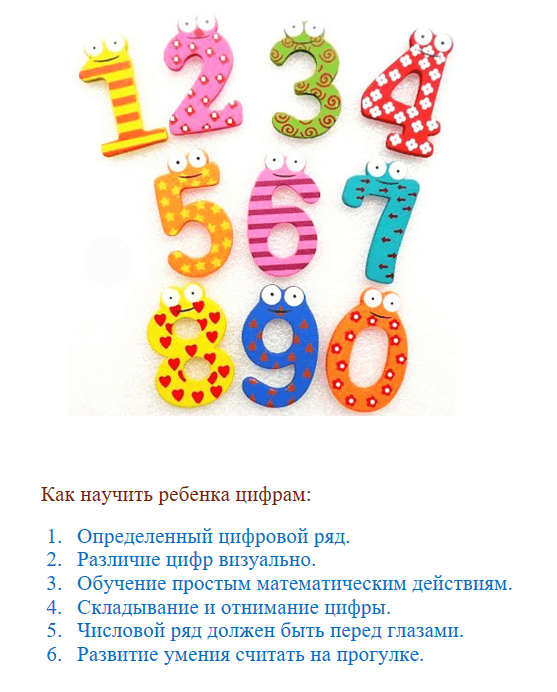 A technique that also consists of planned and regular five-minute lessons will help with this. One way to learn the composition of a number is to print cards on which the number 1 is written and a circle is drawn, the number 2 is drawn, respectively, with 2 circles, etc. Show them quickly.
A technique that also consists of planned and regular five-minute lessons will help with this. One way to learn the composition of a number is to print cards on which the number 1 is written and a circle is drawn, the number 2 is drawn, respectively, with 2 circles, etc. Show them quickly.
Next, close, for example, the number 5, and leave the pictures and let the baby name it himself. Over time, the baby will remember the learned signs and will be able, in this way, to learn the composition of the number without any problems. Scatter them in a chaotic manner and let him give you a specific number. These sessions should be short but regular.
Learning to count to 10
Logic says that initially we learn numbers up to 10, because having learned to understand single digit numbers, mastering counting up to 20 and up to 100 is already easier. True, the number series up to ten is difficult to study. Therefore, the first number should be 5, and, accordingly, all those preceding it.
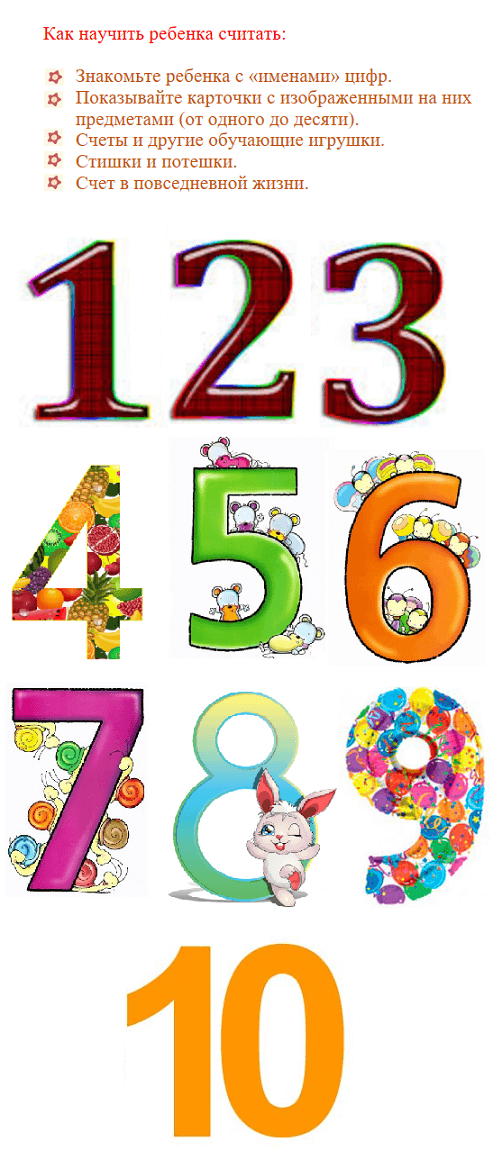
After the first five has been mastered, we move on to the second. The most successful methods to learn numbers:
- Elementary counting- one, two, three, four, five, we lead, of course, with the help of our fingers. Next, taking this into account, you should print out image cards with various objects. We follow the logic - we study the number 1, showing a card with a picture of one object, 2 - two objects, 3 - three, 4 - four, etc. So we will learn the first class of five numbers;
- We use modern Internet resources. There are many opportunities to study numbers for children using the World Wide Web - these are educational cartoons and programs on different languages world, emoticons in numbers, printed on social networks and using applications. In addition, you can print beautiful and interestingly designed icons in the form of numbers found on the Internet, for example, numbers for VKontakte;
- Special toys. These could be sticks, abacus, cubes, etc.;
There are always single-digit numbers in nursery rhymes and nursery rhymes - don’t forget to teach them with your little one; - In the process of household chores Give the baby the opportunity to wash 5 dishes. Connect them and say the quantity - one plate, two plates, three plates, etc. This study is one of the most simple ways learn to count by numbers, and then solve logical problems. This is doubly cool - the child learns to help adults and count at the same time;
- Let the baby remember what to buy and tell him a list of 5 items. When everything is purchased, connect and show the items together.
DIY book in pictures
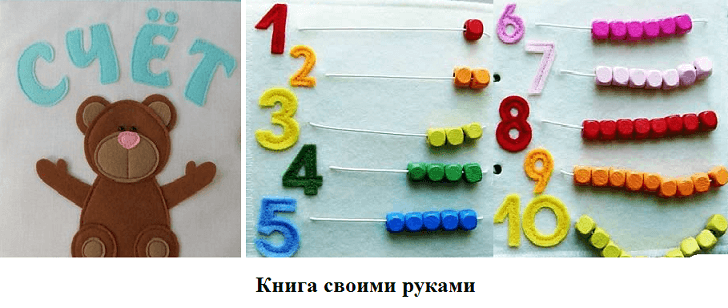
It can cover anything related to calculus. You can print out the photos and paste them there.
- Considering that digital photo processing does not take much time, this will not be difficult. Take photographs of objects familiar to the child and combine in his imagination the photo from the book with the real situation. Leave a place where you can paste icons and count them;
- At the same time, learn to write by numbers. To make the writing process interesting for your son or daughter, draw emoticons with numbers;
- You can make a coloring book with your children that shows large symbols that should be learned and objects that correspond to the number. For example, a car and 4 wheels, or a classroom and several desks. The child will inevitably enjoy the coloring process, and he will unobtrusively remember everything he needs.
With these simple methods, even two-year-old children master numbers and operate with them easily.
- Don't force your baby. The child should not feel like there is a classroom with a teacher in front of him, but rather a cozy and beloved home.
- Everything should be like a game. Whatever complex tasks you did not put it in front of the child, try to constantly play with him. Scientists and mothers all over the world have proven that this way the baby masters any information faster.
- Give yourself enough time, but don't go overboard. Let it be 5 minutes a day, but daily.
- Remembering new information. Simultaneously develop visual, auditory and motor memory.
No less important rule- this is not to compare your baby with other children. You shouldn't blame a child for not being able to count, but the neighbor boy can.



